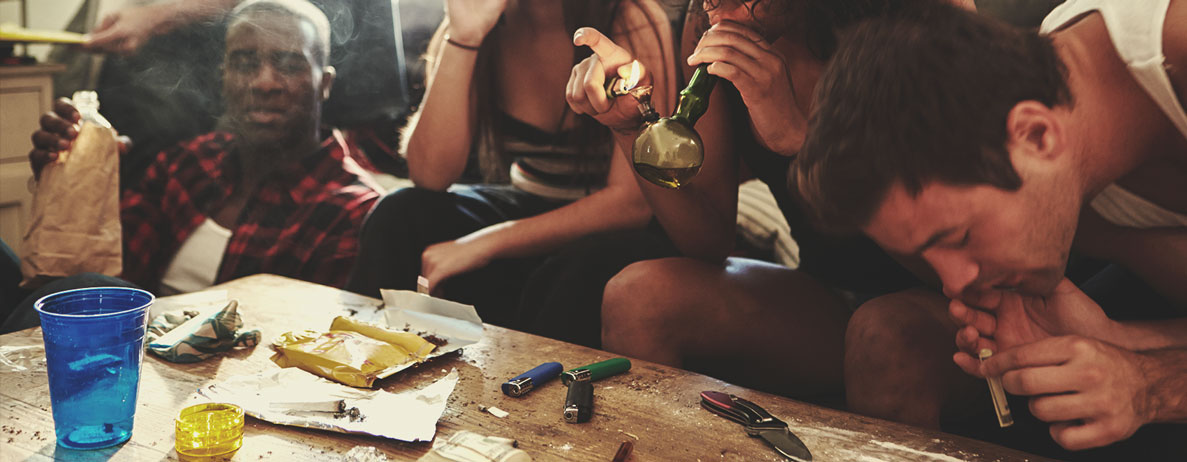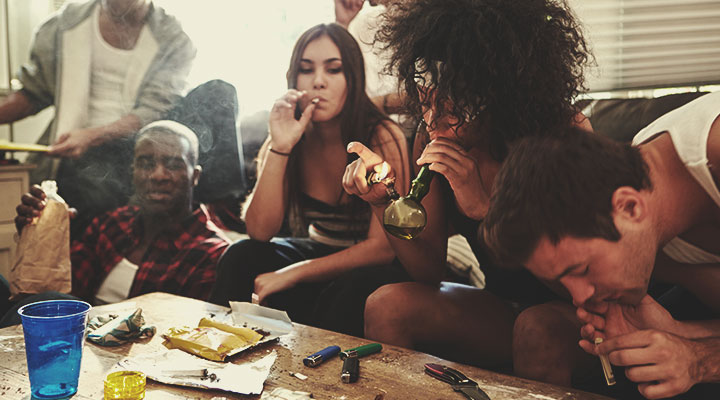.

How Cannabis Interacts With Other Drugs and Medications
Cannabis is an extremely popular substance used for both recreational and therapeutic purposes around the globe. But before you go ahead and mix weed with other substances, read this review of cannabis drug interactions.
Keep reading for our in-depth guide on cannabis drug interactions.
Contents:
Cannabis is a pharmacologically complex plant that, for many reasons (including decades of prohibition), we still don’t fully understand. What we do know, however, is that cannabis’ unique chemical compounds can interact with other external substances (recreational and medicinal), altering our body’s biological processes.
If you’re thinking about mixing cannabis with other recreational substances or prescription medication, keep reading for a detailed overview of how cannabis interacts with other drugs.
Understanding Drug Interactions
A drug interaction is defined as the modification of the effect of a drug by the action of a second drug (prescription medicine or a recreational substance—legal or illicit), food, or drink when they are administered together. These interactions can alter the way one or more of the drugs work, affecting their efficacy in turn.
When you take two or more substances together, a few different outcomes can occur:
- Additive effect: This means each substance produces the effect it is intended to produce independently. Thus, when combined, the effects of both substances are “added” to each other, rather than synergising.
- Synergistic effect: This is when substances combine to produce a greater effect than they would when taken separately.
- Antagonistic effect: This means one or more of the substances taken together become less effective than if they were taken on their own.
Drug interactions occur via numerous mechanisms, including:
- Increasing or decreasing drug absorption in the digestive tract
- Altering drug metabolism in the liver
- Increasing or decreasing the rate at which the body excretes drugs via the kidneys
- By triggering competing actions in the body
A few factors can affect how at-risk you are of experiencing a drug interaction:
- Being dehydrated
- Being very young or very old
- Being over- or underweight
- Having an underlying medical condition
- Taking multiple medications at a time
- Having poor nutrition
How Cannabis Is Broken Down by the Body
Cannabis contains over 100 different cannabinoid compounds, but the ones we know the most about are THC and CBD. Research shows that both compounds are metabolised by cytochrome P450, a group of enzymes responsible for metabolising a large number of substances, including most of the active compounds of prescription medications.
When THC, CBD, and other cannabis compounds are present in our bodies, they could compete for oxidation by the same cytochrome P450 subgroup, which could slow down the metabolism of some other recreational drugs (like LSD, amphetamines, and alcohol, among others), and prescription medications.. Make sure to keep that in mind whenever you’re thinking of combining cannabis with other substances.


What Makes Cannabis Unique to Other Drugs?
Cannabis is unique to many other drugs (both recreational substances and prescription medications) in numerous ways:
- Chemical composition: Cannabis doesn’t contain just one single active ingredient. While THC is by far the most recognized component in cannabis, the plant contains over 400 different compounds of note, including other cannabinoids, terpenes, and more.
- Variety: Cannabis strains vary dramatically. Even strains of the same name can have very different chemical profiles and potencies, and therefore produce very different effects.
- Personal experience: Cannabis affects different people in different ways, and some people may be more tolerant of its effects than others.
- Effects: Cannabis doesn’t fit neatly into the categories we use to classify other substances. While it can definitely be a “downer” (or depressant), it can also produce uplifting effects similar to those produced by stimulants or “uppers”. At the same time, cannabis can produce some of the effects typically associated with hallucinogens (such as a warped perception of time).
Understanding the unique nature of cannabis and, more importantly, how it affects us as individuals, can be very useful in helping us to decide if we try it, when, where, and how to use the herb. If you find cannabis often has a relaxing, sedative-like effect on you, make sure to keep that in mind when mixing it with other substances that have the same or opposite effect.
How Does Cannabis Interact With Other Recreational Drugs?
Cannabis is one of the most commonly used recreational drugs on the planet, even in areas where it remains criminalised. Here’s how it reacts with other recreational drugs.
-
Alcohol
Alcohol is arguably the most popular recreational drug on the planet. And, while you can legally buy almost unlimited amounts of alcohol almost anywhere in the world, it's far from safe, especially when you compare it to other substances.
There’s limited scientific research on the effects of mixing alcohol and cannabis. One study[1] suggests that drinking alcohol prior to consuming cannabis can increase absorption of THC in the body. Elevated levels of THC in the body will not lead to fatality, but it can cause sweating, dizziness, nausea, and vomiting.
-
Amphetamines
Cannabis is often used in conjunction with amphetamines and derivatives like MDMA. Anecdotal evidence suggests cannabis may attenuate some of the negative symptoms of the amphetamine comedown.
Few scientific studies have actually looked at the interaction between cannabis and amphetamines. However, animal studies[2] suggest that the endocannabinoid system may play a role in the addiction cycle, and therefore cannabis could also affect the addictive properties of amphetamines. However, it’s important to remember that amphetamines are stimulant drugs, and cannabis—as it is composed of a variety of different compounds—can produce depressant, stimulant, and even hallucinogenic effects, complicating the interaction between the two drugs.


-
Cocaine
Cocaine is a potent stimulant, and the way it interacts with cannabis can be difficult to pin down. When it acts as a depressant, cannabis might offset the cocaine high, and possibly offset some of the cravings and negative side effects of a cocaine comedown. However, mixing the stimulative effects of cocaine with the depressant effects of cannabis may exacerbate some of the negative side effects of either drug.
Cannabis could also antagonise[3] cocaine-induced blood vessel constriction, which increases absorption of cocaine in the body, resulting in a faster onset and an increased risk of side effects and overdose. When it acts predominantly as a stimulant, cannabis might exacerbate some of the effects of cocaine.
-
Codeine
Codeine is an opioid drug that depresses the central nervous system. When combined with cannabis, the two substances can produce a very sedative and euphoric buzz. And while cannabis isn’t technically classified as a depressant, it can act like one, and therefore have a synergistic effect on codeine and other depressants. Studies[4] have also shown that using codeine with cannabis can cause anxiety and depression.
-
DMT
DMT is a psychedelic drug that’s typically smoked alone. However, it is also consumed with monoamine oxidase inhibitors (MAOI) to create the smokable herb mix known as “changa”, or the ayahuasca brew. There are no formal studies showing how cannabis interacts with DMT, but users often find the two to have a synergistic effect.
Some say, for example, that smoking cannabis before using DMT helps them relax both into and out of the trip. These accounts are similar to those from users of other psychedelics, such as LSD and magic mushrooms. Some "psychonauts" find cannabis to help reduce stomach upset commonly associated with some entheogens, while others say it could catalyse an upset stomach.
-
Ketamine
Ketamine is a dissociative anaesthetic that can be swallowed, snorted, injected, or smoked, often together with cannabis or tobacco. Again, there are no studies into how ketamine and cannabis interact, but users tend to report that cannabis increases the ketamine high and can, in some instances, exacerbate effects like drowsiness and dizziness.
-
LSD
Mixing LSD and cannabis tends to produce a synergistic effect. Many people find that cannabis enhances the visual hallucinations of an acid trip, or even re-triggers them. In fact, it's common to smoke a joint towards the end of an acid trip in hopes of "bringing back" some of the visuals. LSD users often smoke cannabis on the come-up as well, in part to reduce the jitters and nausea associated with the early stages of a trip.


-
Magic Mushrooms
Like with LSD, cannabis tends to have a synergistic relationship with psilocybin mushrooms. Experienced psychedelics users find that combining weed and magic mushrooms usually has positive effects. Keep in mind that the synergistic effects of mixing these two substances can be overwhelming for those new to mushrooms.
-
Salvia Divinorum
Like the other psychedelics mentioned above, cannabis and salvia tend to be synergistic. Nevertheless, cannabis can intensify or calm some aspects of your salvia trip when mixed. On its own, salvia can be described as extremely intense (depending on intake method), causing extreme acute dissociation in some cases.
-
Laughing Gas (NOS)
Laughing gas, or nitrous oxide, is used as a sedative to provide pain relief and produce a calm, giggly euphoria. Cannabis tends to increase the effects of laughing gas, and some people find taking the two together to produce profound sedative effects (especially when taking high doses of the latter), similar to those produced by ketamine.
How Does Cannabis Interact With Prescription Drugs?
As mentioned, studies show that THC and CBD are metabolised[5] by cytochrome p450 enzymes. A subset of these enzymes, known as the CYP3A family, is responsible for metabolising up to 60% of all drugs in use[6]. If you’re taking medication, keep reading to see how cannabis might interact.
-
Blood Sugar Medication
One of the most common blood sugar medications on the market today is metformin, which is prescribed to diabetes patients. Despite the lack of evidence, THC is thought to decrease the effectiveness of this medication. However, other phytocannabinoids are also believed to have potential benefits[7] related to diabetes treatment, including stabilising blood sugar levels.
-
Blood Pressure Medication
Both THC and CBD have been studied[8] to some extent for their impact on blood pressure. Individuals tend to experience lowered blood pressure, and in relationship, an increased heart rate, when taking THC. However, some people—under this low blood pressure scenario—can also experience postural hypotension (a sudden, unpleasant drop in blood pressure when standing up that can cause vertigo, fainting, and nausea) under the influence of THC.
-
Blood Thinners
Some research suggests that cannabis can interact with blood thinners, reducing its effect. On the other hand, some isolated compounds, such as CBD, could cause the opposite effect by inhibiting the metabolism of these drugs. More research is needed to properly understand how cannabis and blood thinners interact.


-
Opioids
Cannabis and opioids don’t seem to interact in a direct fashion, potentially because the compounds within are processed via different systems (the endocannabinoid system and the opioid system, respectively). However, some of the compounds in cannabis have analgesic effects that may complement the effects of opioids used for pain relief. Intriguingly, there is growing clinical evidence[9] to support the use of cannabis as a novel strategy to prevent opioid abuse and fatalities.
-
Sedatives
Studies suggest that cannabis has an antagonistic interaction with sedative medications such as propofol. While everyone experiences cannabis differently, some strains definitely have sedative effects, which may make patients more tolerant of sedative medications. Research[10] from The Journal of the American Osteopathic Association shows that patients who regularly used cannabis needed significantly higher sedative doses prior to an endoscopy than patients who didn’t use cannabis.
-
Antidepressants
There are many different antidepressants on the market, each of which have different effects. In terms of how cannabis interacts with different antidepressants, some people find the herb to produce mood-boosting effects, while others experience exacerbated depression and anxiety symptoms.
-
Antibiotics
Cytochrome P450 enzymes also work to break down certain forms of antibiotics. As both THC and CBD interact with these proteins in a way that inhibits their activity, both could theoretically slow down the liver’s metabolism of antibiotics and increase the risk of side effects. However, little research has explored the interactions between cannabis and antibiotics in humans. Despite this gray area, no major reports exist that detail severe adverse side effects in patients taking the two drugs at one time. Always consult with a medical professional if you plan on continuing cannabis use while undergoing a course of antibiotics.
Mixing Cannabis With Other Drugs — The Bottom Line
Unfortunately, there’s still a whole lot we don’t know about cannabis and the way it affects our bodies—even when taken alone. Hence, if you decide to consume it, we always recommend doing it by itself rather than mixing it with other drugs. Hopefully, as more time and energy goes into understanding cannabis, we’ll have a lot more clarity about how to best use this amazing plant.
Medical DisclaimerInformation listed, referenced or linked to on this website is for general educational purposes only and does not provide professional medical or legal advice.
Royal Queen Seeds does not condone, advocate or promote licit or illicit drug use. Royal Queen Seeds Cannot be held responsible for material from references on our pages or on pages to which we provide links, which condone, advocate or promote licit or illicit drug use or illegal activities.
Please consult your Doctor/Health care Practitioner before using any products/methods listed, referenced or linked to on this website.
- Ethanol increases plasma Delta(9) https://pubmed.ncbi.nlm.nih.gov
- Interactions of Cannabis and Amphetamine-Type Stimulants | SpringerLink https://link.springer.com
- What Happens If You Mix Cocaine And Weed? | The Recovery Village Palm Beach at Baptist Health https://www.floridarehab.com
- The Dangers of Combining Codeine and Weed https://pubmed.ncbi.nlm.nih.gov
- Cytochrome P450 enzymes involved in the metabolism of tetrahydrocannabinols and cannabinol by human hepatic microsomes - PubMed https://pubmed.ncbi.nlm.nih.gov
- The Role of CYP450 Drug Metabolism in Precision Cardio-Oncology https://www.ncbi.nlm.nih.gov
- Cannabis and Diabetes https://www.diabetes.co.uk
- A single dose of cannabidiol reduces blood pressure in healthy volunteers in a randomized crossover study https://www.ncbi.nlm.nih.gov
- Emerging Evidence for Cannabis' Role in Opioid Use Disorder https://www.ncbi.nlm.nih.gov
- Effects of Cannabis Use on Sedation Requirements for Endoscopic Procedures | The Journal of the American Osteopathic Association https://jaoa.org






































